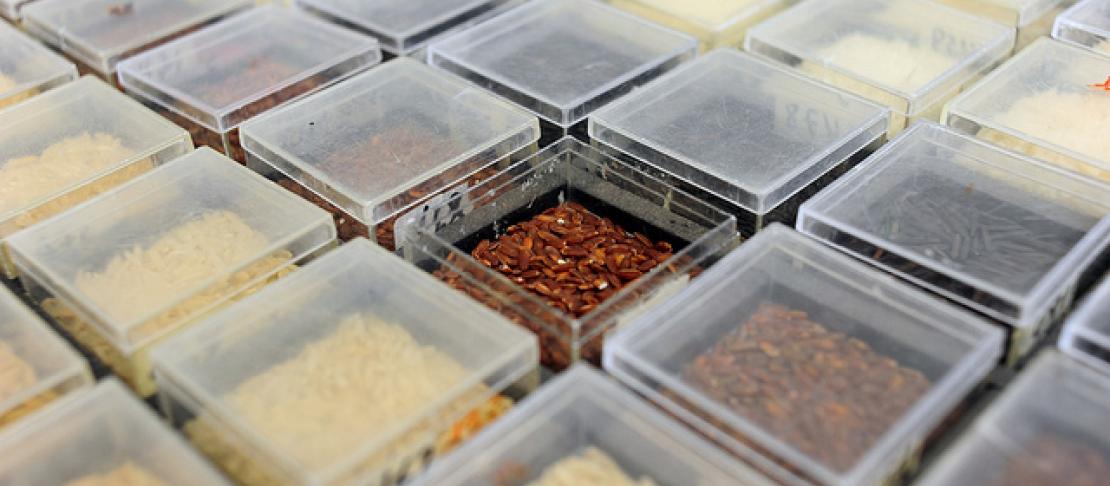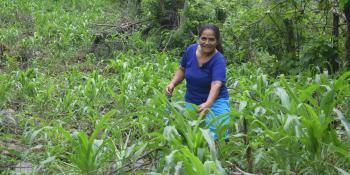Biofortified crops in West Africa aim to improve nutritional quality at the rural level

On World Food Day, CCAFS emphasizes the importance of investing in food security in rural communities with high rates of malnutrition.
According to UNICEF, each year, in West and Central Africa, one million children under five die from causes related to malnutrition. Malnutrition contributes to 35 percent of all the child deaths in the region. The UN Organization adds: «Among the 15 countries in the world with the worst under 5 mortality statistics, 10 are in West and Central Africa. Here, at any time one out of four children are underweight, giving the region the unwanted status of having the highest prevalence estimates for underweight in the world. Malnourished children fall sick more often. When they survive, they can suffer from irreversible mental and physical impairment. »
Hunger and its harmful consequences, as well as micronutrient deficiencies, constitute a threat throughout rural Sahel. The rural populations of Burkina Faso, Niger, Mali, Senegal, and Ghana are highly exposed to risks of food and nutritional crises. Last year, for example, Niger suffered from an extremely severe food crisis. Malnutrition, caused by a lack of essential micronutrients in the diet such as iodine, iron, zinc and vitamin A, also threatens the survival of millions other Africans.
There is no doubt that climate variability and change are major drivers of the increasingly frequent humanitarian crises worldwide. However, its hidden and long-lasting impacts on nutrition and crops quality, are far less known.
As recently recalled in this POLITICO article, major challenges remain today to more comprehensively assess the implications of the tight linkages observed between increases in atmospheric carbon dioxide and the depletion of plants’ proteins and nutrients like calcium, potassium, zinc, and iron.
Biofortified crops for the most deprived
Combating malnutrition in a changing climate context requires crops that are both climate-resistant and have high nutrient potential.
One way that scientists are working to improve the lives of malnourished people in developing countries is through the development of crops that improve human nutrition. The goal of biofortification is to grow nutritious plants which experts consider considerably less expensive than adding micronutrients to previously processed foods.
Biofortification is the process through which the nutritional quality of food crops is improved through agronomic practices, conventional plant breeding, or modern biotechnology.
The Food and Agriculture Organization of the United Nations (FAO) recommends biofortification to combat malnutrition. “Recently, however, there has been a shift: agriculture must now not only produce more calories to reduce hunger but also more nutrient-rich food to reduce hidden hunger,” highlights a publication written by the FAO and the World Health Organization (WHO).
This study by the International Food Policy Research Institute (IFPRI) has summarized evidence showing that biofortified crops can measurably improve human nutrition.
Tapping into agriculture’s enormous potential to make significant contributions to improving nutrition and health, is also at the core of the research agenda of the CGIAR Research Program A4NH and one of its main flagships, HarvestPlus. Some biofortified crops developed through conventional breeding jointly by CGIAR Centers and national partners like the Burkina National Institute for Agricultural Research (INERA) are important staples for the poorest regions of the country, such as orange-fleshed sweet potatoes. Sweet potatoes are rich in vitamin A, and it is the most successful biofortified crop in Africa, according to a study published in the Journal of Nutrition.
A recent study by the International Food Policy Research Institute (IFPRI) has summarized evidence showing that biofortified crops can measurably improve human nutrition.
Climate-Smart Villages try biofortified crops
Given the potential for orange-fleshed sweet potatoe in Burkina Faso, the CGIAR Research Program on Climate Change, Agriculture and Food Security (CCAFS) and partners recently introduced fortified sweet potato cuttings in the Ramdolla Climate-Smart Village (CSV) in the Yatenga province, Northern Burkina Faso.
In 2017, CCAFS, through the Building Resilient Agro-forestry-pastoral Systems through Participatory Action Research project (BRASPAR) led by World Agroforestry Center (ICRAF), introduced three biofortified varieties of millet (ICMV 221 Wbr, GB8735 and Chakti) in the villages of Lemnogo, Ramdolla and Tibtenga. In addition, they introduced three different varieties of sweet potato (Tiébélé, BF 59x CIP and Mother of lineage) in two villages (Lemnogo and Ramdolla), as these villages have suitable growing conditions for the crop.
The International Crops Research Institute for the Semi-Arid Tropics (ICRISAT) developed the biofortified millet varieties introduced in the Niger CSV, and INERA developed and tested the sweet potato varieties in Burkina Faso.
Josias SANOU, a Research Fellow working with CCAFS in the Burkina CSVs explained: "Producers were very enthusiastic to receive these varieties, especially sweet potato. The demands were beyond our ability to provide the cuttings. 135 producers benefited from millet varieties, including 20 women. 60 producers received sweet potato varieties. including 30 women."
According to a booklet produced by IFPRI:
At present, Africa’s predominant sweet potato cultivars are white- or yellow-fleshed varieties that contain small amounts of beta-carotene. By contrast, the [much less common] orange-fleshed varieties are rich sources of beta-carotene. In addition, orange-fleshed varieties are inexpensive and can be grown year-round, making them an ideal source of vitamin A for the poor. If sweet potato could be bred for local growing conditions, and if sufficient demand could be developed, farmers and consumers could switch from non-orange to orange-fleshed varieties, thereby making significant progress toward decreasing vitamin A deficiencies."
In Niger, the same tests are underway in the CSVs located in the village of Fakara. Producers are experimenting with biofortified maize, a rich source of vitamin A.
For the coming agricultural season, Senegal is planning to introduce bio-fortified varieties into its CSVs.
"Dietary sources are either pre-formed vitamin A, as in dairy and other foods from animal sources, or as provitamin A, which are found in plant foods, including maize. Identifying and increasing the supply of maize cultivars rich in provitamin A may greatly improve the health and longevity of people around the world," an IFPRI publication explains.
This introduction was made in the framework of the Building Resilient Agro-forestry-pastoral Systems through Participatory Action Research (BRASPAR) project led by ICRAF in Senegal, Niger, Ghana and Burkina Faso.
CCAFS' mission is to address the critically important issues of global climate change, agriculture, and food security. In its current Phase II, the program is strengthening its efforts to better understand the linkages, synergies, and opportunities for bridging Climate-Smart Agriculture and Nutrition.
A first step on this way, resulting from fruitful exchanges between CCAFS and HarvestPlus colleagues, materialized with the introduction of biofortified crops along with climate-smart technologies in our West Africa Climate-Smart villages to improve the nutritional quality of the population (especially children, women and the elderly). This, besides contributing to dietary diversification, also increases household incomes.
Read more:
Dansira Dembele is the Communications assistant at CCAFS West Africa based at ICRISAT-Mali.
Djibril Dayamba is a Post-Doctoral Fellow - Climate Smart Change at ICRAF
This blog has been realized with contributions from Osana Bonilla-Findji, Science Officer for the CCAFS Climate-Smart Agricultural Practices Flagship



